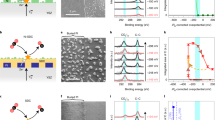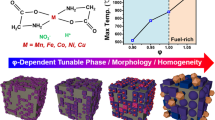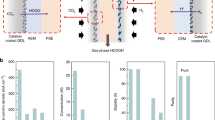Abstract
Solid-oxide fuel cells (SOFCs) promise high efficiencies in a range of fuels. Unlike lower temperature variants, carbon monoxide is a fuel rather than a poison, and so hydrocarbon fuels can be used directly, through internal reforming or even direct oxidation. This provides a key entry strategy for fuel-cell technology into the current energy economy. Present development is mainly based on the yttria-stabilized zirconia (YSZ) electrolyte1. The most commonly used anode materials are Ni/YSZ cermets, which display excellent catalytic properties for fuel oxidation and good current collection, but do exhibit disadvantages, such as low tolerance to sulphur2 and carbon deposition3 when using hydrocarbon fuels, and poor redox cycling causing volume instability. Here, we report a nickel-free SOFC anode, La0.75Sr0.25Cr0.5Mn0.5O3, with comparable electrochemical performance to Ni/YSZ cermets. The electrode polarization resistance approaches 0.2 Ω cm2 at 900 °C in 97% H2/3% H2O. Very good performance is achieved for methane oxidation without using excess steam. The anode is stable in both fuel and air conditions, and shows stable electrode performance in methane. Thus both redox stability and operation in low steam hydrocarbons have been demonstrated, overcoming two of the major limitations of the current generation of nickel zirconia cermet SOFC anodes.
This is a preview of subscription content, access via your institution
Access options
Subscribe to this journal
Receive 12 print issues and online access
$259.00 per year
only $21.58 per issue
Buy this article
- Purchase on Springer Link
- Instant access to full article PDF
Prices may be subject to local taxes which are calculated during checkout



Similar content being viewed by others
References
Minh, N.Q. Ceramic fuel-cells. J. Am. Ceram. Soc. 76, 563–588 (1993).
Matsuzaki, Y. & Yasuda, I. The poisoning effect of sulfur-containing impurity gas on a SOFC anode: Part I. Dependence on temperature, time and impurity concentration. Solid State Ionics 132, 261–269 (2000).
Steele, B.C.H., Kelly, I., Middleton, H. & Rudkin, R. Oxidation of methane in solid-state electrochemical reactors. Solid State Ionics 28–30, 1547–1552 (1988).
Park, S., Vohs, J.M. & Gorte, R.J. Direct oxidation of hydrocarbons in a solid-oxide fuel cell Nature 404, 265–267 (2000).
Perry, E., Tsai, T. & Barnett, S.A. A direct-methane fuel cell with a ceria-based anode. Nature 400, 649–651 (1999).
Primdahl, S., Hansen, J.R., Grahl-Madsen, L. & Larsen, P.H. Sr-doped LaCrO3 anode for solid oxide fuel cells. J. Electrochem. Soc. A 148, 74–81 (2001).
Holtappels, P., Bradley, J., Irvine, J.T.S., Kaiser, A. & Mogensen, M. Electrochemical characterization of ceramic SOFC anodes. J. Electrochem. Soc. A 148, 923–929 (2001).
Pudmich, G. et al. Chromite/titanate based perovskites for application as anodes in solid oxide fuel cells. Solid State Ionics 135, 433–438 (2000).
Marina, O.A., Canfield, N.L. & Stevenson, J.W. Thermal, electrical, and electrocatalytical properties of lanthanum-doped strontium titanate. Solid State Ionics 149, 21–28 (2002).
Marina, O.A. & Pederson, L.R. in Proc. 5th European Solid Oxide Fuel Cell Forum (ed. Huijsmans, J.) 481–489 (European SOFC Forum, Switzerland 2002).
Yokokawa, H., Sakai, N., Kawada, T. & Dokiya, M. Thermodynamic stabilities of perovskite oxides for electrodes and other electrochemical materials. Solid State Ionics 52, 43–56 (1992).
Vernoux, P., Guillodo, M., Fouletier, J. & Hammou, A. Alternative anode materials for gradual methane reforming in solid oxide fuel cells. Solid State Ionics 135, 425–431 (2000).
Sfeir, J. et al. Lanthanum chromite based catalysts for oxidation of methane directly on SOFC anode. J. Catal. 202, 229–244 (2001).
Sfeir, J., Van Herle, J. & Vasquez, R. in Proc. 5th European Solid Oxide Fuel Cell Forum (ed. Huijsmans, J.) 570–577 (European SOFC Forum, Switzerland 2002).
Sauvet, A.L. & Irvine, J.T.S. in Proc. 5th European Solid Oxide Fuel Cell Forum (ed. Huijsmans, J.) 490–498 (European SOFC Forum, Switzerland 2002).
Liu, J., Madsen, B.D., Ji, Z.Q. & Barnett, S.A. A fuel-flexible ceramic-based anode for solid oxide fuel cells. Electrochem. Solid State Lett. A 5, 122–124 (2002).
Nakamura, T., Petzow, G. & Gauckler, L.J. Stability of the perovskite phase LABO3 (B = V, Cr, Mn, Fe, Co, Ni) in reducing atmosphere I. Experimental results. Mater. Res. Bull. 14, 649–659 (1979).
Poeppelmeier, K.R., Leonowicz, M.E. & Longo, J.M. CaMnO2.5 and Ca2MnO3.5 - new oxygen-defect perovskite-type oxides. J. Solid State Chem. 44, 89–98 (1982).
Juhl, M., Primdahl, S., Manon, C. & Mogensen, M. Performance/structure correlation for composite SOFC cathodes. J. Power Sources 61, 173–181 (1996).
Holtappels, P. & Bagger, C. Fabrication and performance of advanced multi-layer SOFC cathodes. J. Eur. Ceram. Soc. 22, 41–48 (2002).
Sauvet A.-L. Study of Novel Anode Materials for SOFCs Under Methane PhD Thesis, L'Université Joseph-Fourier de Grenoble, (2001).
Brown, M., Primdahl, S. & Mogensen, M. Structure/performance relations for Ni/yttria-stabilized zirconia anodes for solid oxide fuel cells. J. Electrochem. Soc. 147, 475–485 (2000).
Acknowledgements
We thank the Engineering and Physical Sciences Research Council (EPSRC) and the New Energy and Industrial Technology Development Organization (NEDO) (All Perovskite Solid Oxide Fuel Cell UK/Asian SOFC Project) for support.
Author information
Authors and Affiliations
Corresponding author
Ethics declarations
Competing interests
The authors declare no competing financial interests.
Rights and permissions
About this article
Cite this article
Tao, S., Irvine, J. A redox-stable efficient anode for solid-oxide fuel cells. Nature Mater 2, 320–323 (2003). https://doi.org/10.1038/nmat871
Received:
Accepted:
Published:
Issue Date:
DOI: https://doi.org/10.1038/nmat871
This article is cited by
-
A fast ceramic mixed OH−/H+ ionic conductor for low temperature fuel cells
Nature Communications (2024)
-
Anode material for solid oxide fuel cell: a review
Indian Journal of Physics (2024)
-
Effect of chromium doping on structural development and electrical properties of LaNiO3 perovskites
Journal of Electroceramics (2023)
-
The review of advances in interfacial electrochemistry in Estonia: electrochemical double layer and adsorption studies for the development of electrochemical devices
Journal of Solid State Electrochemistry (2023)
-
Fuel Cell Reactors for the Clean Cogeneration of Electrical Energy and Value-Added Chemicals
Electrochemical Energy Reviews (2022)



